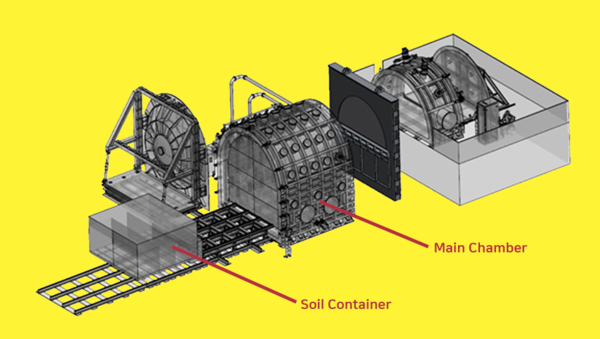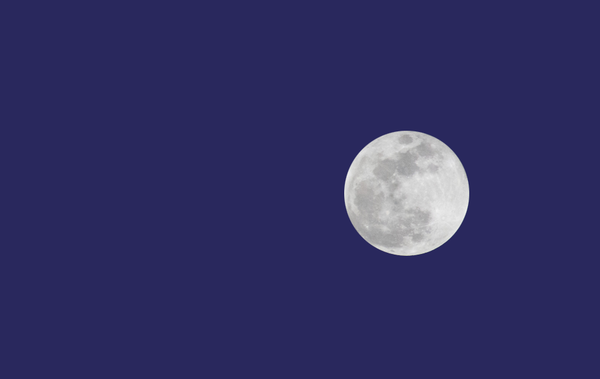
By Sunny Um WIRED Korea
Janggeun Lee, a Korean researcher affiliated with a government-funded research institute, felt challenged when he read a published paper on VF-13, a NASA lunar environmental simulator, three years ago. Authored by Julie Kleinhenz from the Glenn Research Center of the United States, the paper described how efficient it would be when it was tested on the Moon-like surface. Lee convinced himself that, given adequate backing, he could build a similar, or even better, one.
Last month, Lee and his team from the Korea Institute of Civil Engineering and Building Technology(KICT), unveiled the Dusty Thermal Vacuum Chamber, better known as the Moon Chamber, to the public in the institute’s compound in Ilsan, Gyeonggi-do. The chamber was designed to simulate the environmental conditions that space devices would experience on the Moon. This was the first-ever large-scale vacuum chamber filled with artificial lunar soil.
The Moon Chamber
Every space expedition needs testing machines and machine parts to be used in a simulated environment. The more similar the simulated environment is to the actual environment, the lower the margin of error.
Lee, who heads the extreme engineering research center at KICT, says the researchers can evaluate a machine’s durability against the lunar conditions more accurately with the help of the Moon Chamber than with that of any other testbed. Just like the Moon, the chamber has the air pressure that is one 10 millionth of the Earth’s atmospheric pressure and the surface temperatures ranging from -190°C to 150°C as they do on the Moon. Lee says this chamber is designed for space equipment, not astronauts.
Next to the Moon Chamber, there is a container filled with a substitute of lunar soil, which is produced at the facility of the research center. The artificial soil replicates the texture, color, and the static electricity charged with radiation of the real lunar soil. The soil can be deposited up to two meters in height, which is high enough for robots to test-drill it down or travel on. Researchers put the container into the chamber, which has been made airless, to examine the machine’s functions and study on the space dust behavior.

Why the Moon?
Two years ago, U.S. President Donald Trump tasked NASA with a project to send astronauts back to the Moon as it did on Apollo 17, 56 years ago. Vice President Mike Pence said in March: “Not just to travel there, but also to mine oxygen from lunar rocks that will refuel our ships, to use nuclear power to extract water from the permanently shadowed craters of the south pole, and to fly on a new generation of spacecraft that will enable us to reach Mars in months, not years.” The project to kick-start a lunar economy by establishing a long-term base, later renamed as Artemis Program, is currently undertaken together with tens of companies.
South Korea has not shown much interest in human settlement on the Moon, with its aeronautic technology remaining at an early stage, KICT says. South Korea plans to contribute to the Artemis Program and gain experience from the project, as the government-funded Korea Aerospace Research Institute(KARI), aims to launch its first lunar probe in 2022. KARI plans to collect data about the Moon when it sends the orbiter in the space. The spacecraft is designed to carry six instruments, including one from NASA.
Lee believes the Moon Chamber will be a good testbed for many future space missions including those for human settlement on the Moon.
A Very Costly Project
Funding is a big problem for the KICT researchers, given that the Moon Chamber has already been a costly project spanning over three years. To simulate the lunar environment for each test costs more than 100 million won (approximately $84,000).
Launching a new project hinges upon the availability of funding from one of the institute’s sources including the government, and whether researchers will be able to further their research is not certain. To continue with the Moon Chamber project, Lee and his team are trying their best to find their money source.
Building Materials and Builder Robot
One area KICT is keenly interested in with regard to human settlement on the Moon is manufacturing bricks, which are key materials for the building of a base camp. Lee said that it would be too costly, if not impossible, to transport building materials from the Earth to the Moon, given the limited payloads of spacecraft. Lee and his team have developed a basic technology, which makes it possible to harden a lump of lunar soil, which is a size smaller than a thumb, to the strength level of concrete in what is called a sintering process.
Professor Matthias Sperl from the University of Cologne told BBC that approximately 10,000 regular-sized bricks made of hardened lunar soil would be needed to build an igloo-like base camp. “There is no theory or well-known methods for this technology,” said Lee. “It is all based on experiments.”
There have been international efforts to use the lunar soil as a building material for a Moon base camp. The German Space Agency, DLR, is working on a method of making the volcanic powder into bricks using sunlight or laser to hold the materials together. Similarly, the University of Texas Rio Grande Valley introduced a method of consolidating the lunar soil using the chemical reactions of metals.
The problem is making bigger-sized bricks. “Making this lump [as big as a regular-sized brick] is the next assignment of ours,” said Lee. BBC reported that ESA will start bringing up the size to a level it could be used on the Moon.
Builder robots that could carry those heavy bricks are needed in a lunar mission as well. American researchers are in the process of building them, according to KICT. The test robot must be capable of digging the lunar soil, carrying and storing bricks and building the base. Such a test robot could be tested in the Moon Chamber.
Also under development at KICT is a drill that is capable of going down up to one meter in a Moon-like environment. “We tested this drill in Antarctica, but we failed to have a 100 percent success rate yet,” said Lee.
In addition to the Moon Chamber, KICT has developed, or is in the process of developing equipment needed for an expedition to the Moon, including a drill, a laboratory managed with artificial intelligence, a three-dimensional printing system.


 뉴스레터 신청
뉴스레터 신청